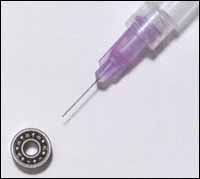| Available Bearings | Bearing Selector | Technical Info | New Products | |||
How to Apply Bearing Adhesive || Dynaroll information about applying bearing adhesive
TECHNICAL INFORMATION
TECHNICAL INFO
Overview & Nomenclature
Materials
Cages/Retainers
Shields and Seals
Ball Bearings - Geometry
Ball Bearings - Tolerances
Ball Bearings - Lubrication
Load Rating and Bearing Lifetime
Ball Bearings - Torque
Ball Bearings - Noise
Mounting and Fitting
Assembly Preload
Ball Bearing Handling
Adhesive Practices
Assembly Characteristics
Useful Conversions
Interested in Mechanical Assemblies?
 Visit our Assemblies Section
Visit our Assemblies Section
Read our Quality Policy
Overview & Nomenclature
Materials
Cages/Retainers
Shields and Seals
Ball Bearings - Geometry
Ball Bearings - Tolerances
Ball Bearings - Lubrication
Load Rating and Bearing Lifetime
Ball Bearings - Torque
Ball Bearings - Noise
Mounting and Fitting
Assembly Preload
Ball Bearing Handling
Adhesive Practices
Assembly Characteristics
Useful Conversions
Interested in Mechanical Assemblies?
Read our Quality Policy
APPLYING ADHESIVE
The following lists "good manufacturing practices" for using adhesive to bond small bearings.
- CLEAN MATING SURFACES
Mating surfaces must be cleaned and free from grease or oils. Since bearings will have been lubricated, it is particularly important to clean the outer surfaces of the rings. In some cases, bearings are available pre-cleaned at the factory (see Bearing Part Numbering System for applicable codes).
- USE PRIMER IF NECESSARY
Anaerobic adhesives require at least one mating surface to have some porosity
to oxygen. If coated or anodized materials are used, then a suitable primer
will be necessary. The use of a primer may also improve bond strength when
dissimilar materials are used in bearings and mating components. See adhesive
manufacturers specifications on primer use.
- CONTROL THE AMOUNT OF ADHESIVE APPLIED
If possible, use an electronic dispenser that delivers an accurately controlled amount of adhesive. This amount should be set to minimize excess adhesive outside the adhesive groove(s). Distribute the adhesive evenly around the circumference of the part.
- SET-UP TIME
The bonded assembly needs to be left undisturbed for enough time that the adhesive "sets up" sufficiently to retain the components in place. This period is specified by the adhesive manufacturer and is different from the time to achieve full cure.
- REMOVE EXCESS ADHESIVE Anaerobic adhesive sets in the absence of air. Any excess adhesive left on the outside of the mating surfaces will not set properly and represents a hazard to the bearing as it may migrate into the raceways, causing damage. All visible excess adhesive should be wiped off after the part has setup. Alternatively, an ultraviolet curing adhesive can be used, where exposure to a strong UV source after set-up will cure any remaining adhesive.

